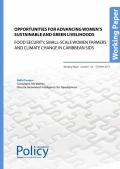This report by the Confederation of British Industry (CBI), a UK business organisation, shows that the UK has the capability to become a key global player in low carbon products and services, which could add £20 billion to annual GDP by 2014/2015. However, government and business must work together in a proactive and pragmatic way to fully maximise the UK’s green growth potential. The CBI calls on the UK to adopt a smarter, and a more consistent and certain approach to energy and climate change policy, to enable business to invest with confidence. The report lists ten recommendations to the government on the green economy:
The purpose of the study is threefold:
(1) to shed more light on the gender dimension of green growth, especially in the context of private sector development and thereby fill an important knowledge gap in the green growth discourse;
(2) to validate women’s contributions to green growth and sustainable private sector development; and
(3) ultimately to promote women’s empowerment and gender equality.
The overall approach of the study combines three intersecting perspectives, which are dealt with independently as well as in tandem: a gender perspective with a focus on the (potential) participation of women, a greening perspective and a private sector development perspective.
The study contains case studies from Brazil, Ecuador, Egypt, India, Philippines, South Africa, Uganda and Vietnam.
Green jobs represent a new kind of employment which is not yet caught in the history and inertia of social inequity. This could represent an opportunity for a more equitable sharing of revenue between capital and labour. This opportunity may also help women into career path’s that will allow them to become more financially secure and support themselves and their families.
The recent study undertaken falls into this type of combined exercise, demanding a change towards a sustainable production model, and at the same time shedding light on what kind of jobs should be defended and which should not, and which policies to promote or reject. The paper sets the challenge of analysing and putting forward proposals for discussion from working women, advancing towards a gender perspective, as other studies on green jobs have included little or no reference to women workers.
Climate change is one of the greatest global challenges of the twenty-first century for developed and developing countries alike. Though developing countries have contributed the least to the causes of climate change, they stand to suffer more due to their vulnerability to extreme environmental events. Women and men working in sectors most dependent on the weather, such as agriculture and tourism, are likely to be most affected. Climate change, moreover, is not gender neutral. Women are increasingly being seen as more vulnerable than men to the effects of climate change because they represent the majority of the world’s poor and are proportionally more dependent on threatened natural resources. What is more, women tend to play a greater role than men in natural resource management – farming, planting, protecting and caring for seedlings and small trees – and in ensuring nutrition and as care providers for their families. Yet, in the long run, no one – women or men, rich or poor – can remain immune from the challenges and dangers brought on by climate change.

